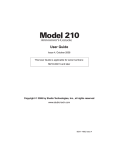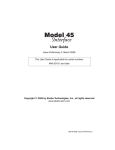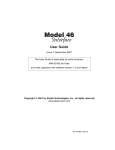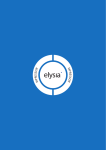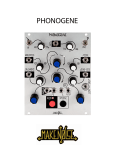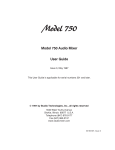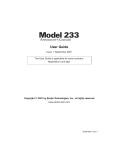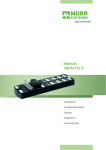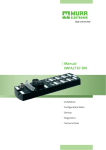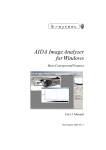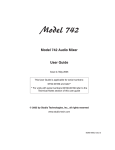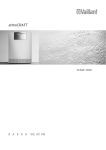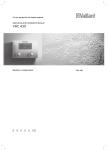Download Simplicity 740 User guide
Transcript
Model 740 Model 740 Audio Mixer User Guide Issue 3, May 2004 This User Guide is applicable for serial numbers: M740-00151 and later © 2004 by Studio Technologies, Inc., all rights reserved www.studio-tech.com 50026-0504, Issue 3 This page intentionally left blank. Model 740 Table of Contents Introduction ................................................................... 5 System Features ........................................................... 6 Configuration Review .................................................... 8 Installation ..................................................................... 9 Post-Installation Calibration .......................................... 14 Operation ...................................................................... 15 Technical Notes ............................................................. 21 Specifications ................................................................ 24 Block Diagram Model 740 User Guide Studio Technologies, Inc. Issue 3, May 2004 Page 3 Model 740 This page intentionally left blank. Issue 3, May 2004 Page 4 Model 740 User Guide Studio Technologies, Inc. Model 740 Model 740 Introduction What This User Guide Covers This User Guide is designed to assist you when installing, configuring, and using the Model 740 Audio Mixer. Additional background technical information is also provided. A product block diagram is included at the end of this guide. System Overview The Model 740 Audio Mixer is expressly designed for use in compact electronicnews-gathering (ENG) vehicles. Many other audio production applications can also be supported. Model 740 features include six mic/line inputs, a monaural output bus, LED metering, and a flexible monitoring section. It’s important to note that the feature set was carefully selected to provide exactly what’s needed —and no more! Keeping it simple was the design mantra. The Model 740 is targeted for use by operators that have a multitude of tasks to perform, and too little time to do them. Using its experience in mobile broadcast applications, Studio Technologies was able to design the Model 740 to include all the crucial features required to meet the needs of fast-paced news-gathering operations, while still providing the operator with an extremely easy-to-use product. The hallmarks of the Model 740 are application flexibility, simplicity in use, audio quality, and long-term reliability. A number of internal configuration jumpers allow the unit’s performance to be tailored to the needs of specific installations. The carefully selected feature set ensures that the Model 740 will be a “team player” when it’s integrated into an audio system. While there’s flexibility on the inside, the operator is presented with an easy-to-use set of front-panel controls and indicators—the operator never has to access the back panel to operate the unit. In this way the goal of delivering successful on-air and production audio, day-after-day, can best be achieved. The Model 740’s audio quality is “pro” throughout. The components were carefully selected to deliver low-noise, low-distortion performance. Model 740 Front Panel Model 740 Back Panel Model 740 User Guide Studio Technologies, Inc. Issue 3, May 2004 Page 5 Model 740 Reliability over the long haul was a Model 740 design criteria. To that end the unit’s enclosure is made of steel, combining strength with effective RF rejection. On the inside, all components are mounted on an FR4 (fiberglass-based) circuit board assembly. System Features Mic/Line Inputs Six input channels are provided for connection to microphone or line-level signals. The electronically balanced circuitry is “ruggedized” for reliability under tough operating conditions. The low-noise, low-distortion, high-headroom audio performance is what’s expected of sophisticated “pro audio” equipment. Features provided for each input channel include an input sensitivity button, rotary level control, and level status LED. For ease of use, the rotary level control sets both the gain of the input circuit and the level being sent to the main audio bus. For convenience the six input sensitivity buttons, like all the Model 740’s operator controls, are located on the front panel. For operator assistance, the bicolor level status LED provides signal present and peak level indication. Main Output Signals from the six mic/line input channels combine to create a monaural signal called the main output bus. A rotary control sets the overall level of the main bus. An electronically balanced output circuit is associated with the main output bus. It provides a line-level signal capable of driving balanced or unbalanced loads of 600 ohms and greater. A studio-quality audio compressor circuit is provided to Issue 3, May 2004 Page 6 control the dynamic range of the main audio bus. An LED indicator lights whenever the compressor circuit is actively controlling the signal. Far from a simple “clipper,” the compressor circuit utilizes a sophisticated laser-trimmed voltage-controlled amplifier (VCA) integrated circuit for quiet, low-distortion operation. To help minimize operator error, no compressor on/off switch is provided on the Model 740’s front panel. An internal 3-position configuration jumper determines the compressor circuit’s operating mode. From the factory the jumper is set so that the compressor’s operating threshold is 6 dB above the nominal +4 dBu output level. This is an excellent general-purpose setting for broadcast use where voice signals are the primary audio content. To meet the needs of other installations, a technician can change the jumper to make the threshold 2 dB above the nominal +4 dBu. This could prove useful when using the Model 740 with level-sensitive RF transmission systems. For other applications a technician can set the jumper to a third position which completely disables the compressor function. Monitor Section The Model 740’s monitor section provides a line-level monitor output, along with two headphone outputs. Associated with the monitor section is a rotary level control and a 3-position source select switch. The monitor output is compatible with a variety of monitor amplifiers and amplified loudspeakers. For flexibility, two headphone output jacks are provided, one on the front panel and one on the back. Each headphone jack is supported by an independent output circuit. A 3-position toggle switch is used to select the audio source Model 740 User Guide Studio Technologies, Inc. Model 740 to be monitored. This allows monitoring of the main audio bus, along with two external monaural audio sources. These external monitor inputs are intended to be connected to devices such as off-air, microwave, or satellite receivers. Alternately, other mobile broadcast support equipment, such as a PC-based editing system, can be connected. Unique to the Model 740 is the ability to configure the monitor output to meet the needs of the “real world.” This is accomplished by using an internal 3-position configuration jumper to select the monitor output mode. From the factory the monitor output is configured to “follow” the setting of the front-panel level control. In addition, the monitor output mutes whenever a pair of headphones is plugged into the frontpanel jack. A technician can change the jumper position so that the monitor output still follows the setting of the front-panel level control, but is not impacted by use of the front-panel headphone jack. A third jumper position allows a technician to configure the monitor output such that it is electrically before (“pre”) the level control. As with the previous mode, the output isn’t impacted by use of the headphone output. This mode is very useful when an amplified loudspeaker that contains a user-accessible level control is connected. Examples of amplified speakers that contain user level controls include the popular Fostex® 6301-series. With the jumper in the pre-level-control position, only one level control—the one on the amplified speaker—would be used to set the speaker level. This can greatly minimize operator confusion while still utilizing the resources of the Model 740’s monitor section. Model 740 User Guide Studio Technologies, Inc. Metering A 10-segment LED meter provides an indication of audio-signal level. An internal selection jumper determines the audio source for the meter. From the factory the meter is set to monitor the signal level of the main audio bus. A technician can change the configuration so that the meter monitors the source selected by the monitor section’s 3-position switch. In this way the level of the main audio bus, as well as the two external monitor sources, can be displayed by the meter. Reference Tone A sine-wave audio tone is provided for alignment and reference use. From the factory the tone is configured for 400 Hz. If required, a technician can revise the frequency to be 1 kHz. A button on the Model 740’s front panel allows the tone to be connected to the main audio bus. In addition, a dedicated reference tone output is also provided. This continuous source of sine-wave signal is accessed by means of a balanced line-level output on the back panel. The dedicated reference tone output is intended to provide a setup or test signal that is available at all times, and without interfering with normal operation of the main audio bus. Mounting, Connectors, and Mains Power The Model 740 requires one space in a standard 19-inch rack. Industry-standard XLR-type and ¼-inch 3-conductor audio connectors are used for all audio interconnections. To maximize reliability, all connectors were selected to be premium grade. For example, the XLR-type connectors feature metal shells and are manufactured by Neutrik. AC mains power Issue 3, May 2004 Page 7 Model 740 is connected directly to the Model 740 by way of a standard 3-pin detachable IEC cord set; no external power supply is used. AC mains power is factory configured for 100, 120, or 220/240 V, 50/60 Hz. Configuration Review In this section you will be reviewing the configuration of the Model 740. Configuration changes can be made if required. Any changes should be made prior to installing the unit. As previously mentioned in this guide, four Model 740 operating parameters can be configured to meet the needs of specific applications. These include compressor mode, monitor output mode, meter source, and reference tone frequency. While simple to perform, all changes do require the skill of a technician. This person must ensure that AC mains power is disconnected prior to removing the unit’s cover. Then the locations of one or more of the configuration jumpers can be moved. In the case of the reference tone frequency, a calibration trim pot must also be adjusted. Compressor Mode The compressor can be configured to operate from one of three modes: • From the factory the compressor is set to have an operating threshold of 6 dB above the main output’s nominal +4 dBu operating level. In other words, the compressor will begin to function when the level of the main output reaches about +10 dBu. This is an excellent general purpose setting that is appropriate for most applications. Issue 3, May 2004 Page 8 • Alternately, the compressor’s threshold can be changed to be 2 dB above the +4 dBu operating level. This may be appropriate for applications where an RF transmission chain places severe restrictions on the audio signal’s dynamic range. • While not recommended for most applications, the compressor can also be configured to be disabled. With this configuration, no dynamic range control will take place. For most on-air applications it’s unlikely that this would be appropriate. Monitor Output Mode The monitor output can be configured to operate from one of three modes: • From the factory the monitor output is set to follow the position of the frontpanel rotary level control. This mode of operation is sometimes referred to as being “post” the level control. In addition, plugging a pair of headphones into the jack on the front panel will cause the monitor output to mute. • An alternate configuration is available that makes the monitor output follow the rotary level control’s setting. But plugging headphones into the front panel doesn’t cause muting of the monitor output. This allows the monitor output to be active, whether or not the headphones are plugged in. • A third mode is specifically provided for use in applications where an amplified loudspeaker with built-in user level control is connected. This “pre-levelcontrol” mode allows the user to select the source to be monitored on the Model 740’s front panel. But only the level control on the amplified speaker is used Model 740 User Guide Studio Technologies, Inc. Model 740 to adjust its volume. This prevents the confusing situation of having two level controls—the Model 740’s level control and the amplified speaker’s level control—both impacting the speaker level. In this case the Model 740’s front-panel control will only impact the headphone output level. Meter Source The meter source can be configured to operate from one of two modes: • From the factory the meter is selected to always monitor the level of the main output bus. This ensures that the level of the active or “on-air” output is always displayed on the meter. Changing the monitor source will not impact meter operation. • An alternate jumper setting allows the meter to “follow” the source selected for monitor output. This could prove useful if level metering of the external monitor input signals is desired. Reference Tone Frequency From the factory the frequency of the reference tone is configured to be 400 Hz. This is a nice alternative to the more typical 1 kHz, a frequency which can soon become very annoying to a listener’s ears. In most cases 400 Hz will be perfectly acceptable, and actually preferred. But in those situations where 1 kHz is necessary, configuration jumpers can shift the frequency range so that the oscillator circuitry can be calibrated for 1 kHz. Configuration Wrap-Up If it is determined that any configuration changes are required, they should now have been performed. For specific details Model 740 User Guide Studio Technologies, Inc. on how to make configuration changes, refer to the Technical Notes section of this guide. The details provided should have made the process simple and relatively painless. Installation In this section, the Model 740 will be installed in an equipment rack. Input and output connections will be made using the Model 740’s multitude of jacks. Finally, AC mains power will be connected. System Components The shipping carton contains a Model 740 Audio Mixer and user guide. Units destined for North America and Japan also include an AC mains cord. Your dealer or distributor will provide an AC mains cord for non-North American destinations. Locating the Unit Now that the Model 740’s configuration has been reviewed and, if required, revised, the unit can be mounted in an equipment rack. Physical access and viewing angles are the primary issues to be considered when choosing a mounting location. By its very nature as an audio mixer, an operator will need easy access to all the controls. Also, a good sight line to the 10-segment LED level meter, located on the right side of the front panel, can be important. As a device that contains high gain audio stages, hum and noise pickup is possible by way of the chassis and associated cabling. Locating the unit away from devices that radiate strong AC fields is an excellent idea. While not likely, it is also possible that the Model 740’s toroidal power transformer could radiate energy into adjacent Issue 3, May 2004 Page 9 Model 740 equipment. It is located at the far right side of the unit, and may need to be physically isolated from sensitive equipment such videotape recorders. 740’s 3-pin IEC 320 C14-compatible inlet connector. During normal operation, access to the Model 740’s back panel is not required. However, there is one trim potentiometer that may need to be adjusted prior to the Model 740 going into service. This trim pot sets the level of the reference tone direct output. Please refer to the Post-Installation Calibration section of this guide for details. The Model 740 contains six input channels that are compatible with microphone or line-level sources. Each input uses a 3-pin female XLR-type connector. Prepare the mating connectors (males) so that pin 2 is signal high (+ or hot), pin 3 is low (– or cold), and pin 1 is shield. Mounting The Model 740 is intended for mounting in a standard 19-inch equipment rack, requiring 1.75 vertical inches (one standard rack space). It weighs approximately 7.0 pounds (3.2 kg) and operates on mains power of 100, 120, or 220/240 V, 50/60 Hz. The maximum operating power is less than 24 watts. Four mounting screws, two per side, are used to secure the unit into the equipment rack. Connections The Model 740’s input and output connections are made using 3-pin XLR-type male and female connectors and ¼-inch 3-conductor phone jacks. AC mains power is connected by means of a detachable cord set that is compatible with the Model Mic/Line Inputs It’s possible that some of the mic/line inputs will be wired to an input/output (I/O) panel located on the side or rear of a broadcast vehicle. If this is the case, it’s also nice to have one or two of the inputs “multed” to connectors inside the vehicle. This will allow the rapid connection of microphone or line-level signals during specialized situations. For example, during inclement weather on-air talent may wish to connect a microphone to the Model 740 from inside a vehicle. To minimize potential problems, it is recommended that microphone-level signals connected to the mic/line inputs not be wired by way of points on an audio patch bay. It certainly can be done, but the potential for intermittent connections, especially in mobile applications, may significantly increase. Detail of back panel showing mic/line input connectors Issue 3, May 2004 Page 10 Model 740 User Guide Studio Technologies, Inc. Model 740 Main Output—General Information The Model 740 contains one output that is associated with the main audio bus. It is electronically balanced, capacitor coupled, and has a nominal level of +4 dBu. The output circuitry is capable of driving balanced or unbalanced loads of 600 ohms or greater. Note, however, that as the load impedance approaches 600 ohms the output level will drop slightly. A 0.5 dB difference in output level can be expected as the load impedance changes from 10 k ohms to 600 ohms. This loading situation also applies to the monitor and reference tone direct outputs as well. The output utilizes a 3-pin male XLR-type connector for interconnection. Prepare the mating connector (female) so that pin 2 is signal high (+ or hot), pin 3 is low (– or cold), and pin 1 is shield. Whether this output is wired via a patch bay will depend on the specific installation. But at least having a “mult” of the main output on a patch point is probably a good idea. While balanced operation is generally preferred, unbalanced operation is not a problem for the output circuitry. To connect to an unbalanced load prepare the mating connector (female) so that pin 2 is high (+ or hot), and both pins 1 and 3 are shield. For optimal unbalanced operation, it is important to connect both pins 1 and 3 together directly on the connector that mates with the Model 740, not at the other end of the cable. External Monitor Inputs Detail of back panel showing main output connector Note that the main output is intended only for connection to devices located within a broadcast vehicle or dedicated indoor facility. While the output circuitry is robust and sonically excellent, it’s not intended for direct exposure to the extreme conditions that can occur in the nasty “outside world.” This limitation is normally not an issue as the main output will typically be connected to the input of a distribution amplifier. Should the main output need to be connected directly to a vehicle’s I/O panel, at a minimum a 1:1 isolation transformer should be placed in its path. Model 740 User Guide Studio Technologies, Inc. Two external audio signals can be connected, allowing them to be monitored independently of the activity on the main audio bus. It is intended that the external monitor inputs be connected to outputs associated with devices such as off-air, microwave, or satellite receivers, or other specialized devices such as PC-based video editing systems. The inputs are Detail of back panel showing external monitor input connectors Issue 3, May 2004 Page 11 Model 740 monaural, electronically balanced, and have a nominal level of +4 dBu. Audio sources are connected to the external monitor input’s 3-pin female XLR-type connectors. Prepare the mating connectors (males) so that pin 2 is signal high (+ or hot), pin 3 is low (– or cold), and pin 1 is shield. With an unbalanced source connect pin 2 to high (+ or hot) and both pins 1 and 3 to shield. If connecting to an unbalanced source in this manner results in hum or noise, connect pin 2 to high (+ or hot) and pin 3 to shield; leave pin 1 unterminated. Monitor Output The monitor output is designed to connect to an audio power amplifier associated with a monitor loudspeaker. In mobile applications it’s also popular to use a loudspeaker with an internal amplifier, such as those from Fostex. The monitor output is electronically balanced, capacitor coupled, line level, and can drive a balanced or unbalanced load of 600 ohms or greater. The nominal output level has been optimized to match the input sensitivity typically found on audio amplifiers. The monitor output utilizes a 3-pin male XLR-type connector for interconnection. Prepare the mating connector (female) Detail of back panel showing monitor output connector Issue 3, May 2004 Page 12 so that pin 2 is signal high (+ or hot), pin 3 is low (– or cold), and pin 1 is shield. To connect to an unbalanced load connect pin 2 to high (+ or hot) and both pins 1 and 3 to shield. Whether or not this output is wired via a patch bay will depend on the specific installation. Reference Tone Direct Output Direct access to a continuous source of sine-wave reference tone is provided by means of a line-level output. As one of the unique features of the Model 740, it should definitely be utilized! This output is intended to be connected to the audio input associated with a audio/video switcher’s “bars and tone” position. For maximum flexibility, it is recommended that this signal be routed via a patch bay. In this way it can be easily accessed for other test and calibration purposes. The reference tone direct output is electronically balanced, has a nominal +4 dBu level, and is accessible via a 3-pin male XLR-type connector. The output circuitry is capable of driving a balanced or unbalanced load of 600 ohms or greater. Prepare the mating connector (female) so that pin 2 is signal high (+ or hot), pin 3 is low (– or cold), and pin 1 is shield. To connect to an unbalanced load Detail of back panel showing reference tone direct output connector, associated level trim pot, and headphone output jack Model 740 User Guide Studio Technologies, Inc. Model 740 connect pin 2 to high (+ or hot) and both pins 1 and 3 to shield. A trim potentiometer, accessible from the back panel, is used to set the precise output level of the reference tone direct output. After an installation has been completed it may be desirable to set the trim pot to provide the required level. For details please refer to the Post-Installation Calibration section of this user guide. Headphone Outputs The Model 740 contains two headphone outputs, one on the front panel and one on the back panel. Both jacks are ¼-inch 3-conductor (“stereo”) tip-ring-sleeve type. The jack on the front panel is intended to allow an operator to plug in a pair of headphones as needed. No permanent connection should be made to this jack. The headphone output jack on the back panel is provided so that a remote headphone output jack can be installed. This could prove useful in cases where a headphone jack might be desired on an I/O panel located at a PC-based editing location, small voice-over room, etc. Separate output circuitry is used for the front-panel and back-panel headphone outputs. Depending on the configuration of the Model 740’s monitor output, the front-panel headphone output may cause the monitor loudspeaker to mute. This is not the case with the back-panel headphone output. A connector plugged into the back-panel headphone jack will never impact the monitor output. Note that while the Model 740 is a singlechannel (monaural) device, the headphone outputs are configured to drive stereo headphones. If possible, any Model 740 User Guide Studio Technologies, Inc. plug used with either headphone output should be a 3-conductor (stereo) type. A 2-conductor plug will short the ring and sleeve leads together, causing additional loading to the headphone output circuit. While not something that will cause a reliability issue, it’s preferable if the rightchannel output is not shorted. There may be cases where a remote location may need to support a monaural earpiece, such as a talent voice-over position. In this case simply connect only the tip and sleeve connections on the 3-conductor plug used to mate with the Model 740’s back-panel jack. Connecting AC Mains Power The Model 740 is factory configured to operate from AC mains power of nominal 100, 120, or 220/240 V, 50/60 Hz. A maximum of 24 watts of power is required. Units shipped to locations within North America are factory configured for 120 V operation and are supplied with an internal 0.2 A, 5 x 20 mm time-lag fuse. Units shipped to Japan are factory configured for 100 V operation and use the same 0.2 A, 5 x 20 mm time-lag fuse. Units configured for 220/240 V operation are supplied with a 0.1 A, 5 x 20 mm time-lag fuse. Detail of back panel showing AC mains power connector Issue 3, May 2004 Page 13 Model 740 Before connecting the Model 740 to AC mains power, determine the actual mains voltage and confirm that the Model 740 has been configured appropriately. As could be expected, an incompatible mains voltage configuration could seriously damage the unit. Should it be necessary to change the unit’s operating voltage contact Studio Technologies’ technical support personnel for details. The Model 740 uses a 3-pin IEC 320 C14-compatible inlet connector to mate with a detachable mains cord set. For units shipped to North America and Japan, a cord is supplied that has a NorthAmerican (NEMA 15L) standard plug on one end and an IEC 320 C13-compatible connector on the other. Units bound for other destinations require that the appropriate cord set be obtained. The wire colors in the mains cord must conform to the internationally recognized color code and should be terminated accordingly: Connection Wire Color Neutral (N) Live (L) Earth/Ground (E) Light Blue Brown Green/Yellow Because the Model 740 contains no AC mains on/off switch it will begin operation as soon as AC mains power is connected. Post-Installation Calibration Reference Tone Direct Output If the reference tone direct output is used, it’s important to confirm that its output level is correct for the installation. In most cases the output level will need to be adjusted to match the precise Issue 3, May 2004 Page 14 requirement of the system. This is because the load applied to the output may well be different than the 100 k ohm load that is applied at the factory. As previously noted, while the output circuitry is capable of driving loads of 600 ohms or greater, the output level will drop slightly as the load impedance changes, especially as it approaches 600 ohms. Detail of back panel highlighting reference tone direct output connector and associated level trim pot Depending on the Model 740’s internal configuration the tone frequency will be either 400 Hz or 1 kHz. A trim potentiometer allows adjustment of the output level over a range of approximately +3 to +7 dBu. The trim pot is accessible by way of a small access hole in the back panel, adjacent to the reference tone direct output’s male XLR-type connector. At the factory this output is loaded with 100 k ohms and then the trim pot is adjusted to give an output level of +4 dBu. In practice, calibrating the output level is quite simple: 1. Confirm that the reference tone direct output is terminated with its normal load impedance. 2. Ensure that the Model 740 is connected to AC mains power. Model 740 User Guide Studio Technologies, Inc. Model 740 3. Using an appropriate adapter cable, connect a high-input-impedance audio level meter directly across the reference tone direct output. Ensure that this meter connection does not remove the normal load! The level meter must be a precision device that’s intended for audio use—a general-purpose voltmeter is not adequate! For a great look it is recommended that Brother® P-Touch ¼-inch (6 mm) labels be created. Selecting tape material that prints white text on a black background works out perfectly for the Model 740. The Brother label cassette number TX-3151, white on black, is appropriate for use with some of their printers. 4. While carefully observing the level meter, adjust the trim pot to give the desired output level. Operation Labeling the Unit for Clarity Once the Model 740 has been installed, installation-specific labeling of the front panel may want to be performed. This additional clarity can greatly assist operators in correctly using the unit. For example, instead of the first mic/line input channel having the factory-standard text INPUT 1, it could reflect its exact function, such as TAPE 1. The unit’s front-panel graphics were specifically created to simplify the task of adding custom labels. Under each section heading text is a horizontal green line, which, besides looking pretty sharp, is intended to serve as a “guide” for adding installation-specific labels. The distance from the guide line to the top of the unit was specifically designed to allow ¼-inch-high label material to fit correctly. While the Model 740 Audio Mixer is quite simple to operate, there are nuances in its design that make a detailed discussion worthwhile. We’ll start with the individual sections that make up the Model 740, then we’ll review how the sections work together to become your audio “master control.” Mic/Line Inputs Six identical input channels are provided, each being compatible with a microphone or line-level signal. The following provides a detailed description of one of the mic/ line inputs: Detail of front panel showing one mic/line input channel Detail of front panel showing installationspecific label Model 740 User Guide Studio Technologies, Inc. Input Sensitivity The input circuitry is compatible with a wide range of signal levels and is protected from overload. The mic/line button is used to select the sensitivity of the input. Issue 3, May 2004 Page 15 Model 740 In the mic (out) position, the expected nominal input level range is –55 to –35 dBu. In the line (in) position, a 43 dB pad is inserted into the circuit, making the expected nominal input level range –12 to +8 dBu. Status LED A bicolor LED acts as a user-confidence indication of the overall signal level in the mic/line input channel’s circuitry. The LED will light green as a signal present indicator, showing that the input signal, along with the gain of the input preamplifier, is at least 18 dB below the nominal internal operating level. The LED will light red as a peak signal indicator, showing that the input signal, along with the gain of the preamplifier, is within 6 dB of the circuitry’s maximum level. Level Control The rotary control is used to adjust the gain of the input section’s preamplifier circuitry. In the fully counterclockwise position the preamplifier gain is set to its minimum, and full attenuation is achieved. This means that no signal continues on to the mixing circuitry that creates the main audio bus. As the level control is rotated in the clockwise direction the gain of the preamplifier increases. Master Output The Model 740’s master output section has one LED indicator and one rotary control associated with it. Master Level Control One rotary control is used to set the overall level of the main audio bus. On the front panel, note the graphic symbol and the letter “U,” located at the approximately Issue 3, May 2004 Page 16 “1-o’clock” rotational position. This indicates the correct setting for the master output section to give unity gain, and is the position where the control should normally be set. Detail of front panel showing master level control, compressor active LED, and reference tone on/off button Reference Tone A sine-wave tone can be connected to the main audio bus, serving as a reference signal for local and remote use. A pushbutton switch selects its status; when the switch is in the on (in) position tone is connected. An LED indicator, which is located directly below the switch, lights whenever tone is being sent to the main bus. The distinctive blue color of the LED is intended to clearly alert the user that tone is active. The level of the tone generation circuitry is adjusted at the factory to match the Model 740’s internal operating level. When the tone is connected to the main audio bus, the master level control can be adjusted to give a +4 dBu indication on the level meter. Compressor A studio-quality compressor circuit is associated with the main audio bus. A yellow LED, located to the left of the master level rotary control, lights whenever the compressor is controlling the Model 740 User Guide Studio Technologies, Inc. Model 740 dynamic range of the main bus. The operating threshold of the compressor and associated LED depends on how the Model 740 has been configured: • From the factory the compressor threshold is set to be 6 dB over the Model 740’s nominal operating level. This correlates to a level on the main output connector of +10 dBu. with signals slightly higher than normal. The red LED will light whenever the signal level is in the “headroom” area. The ballistics of the meter is a cross between that of a VU and a peak (PPM) meter. (We affectionately refer to it as a “PU” meter!) The way the LEDs “move” in response to signals should be comfortable for most users to observe. • The compressor’s configuration can also be revised so that the threshold is 2 dB over nominal. This correlates to a nominal level on the main output connector of +6 dBu. With this configuration the compressor may be active quite frequently during typical Model 740 operation. • A third configuration is also available which serves to disable the compressor. In this case dynamic range control will never take place and the LED will never light. If the configuration is set to use one of the two thresholds, i.e., the compressor is not disabled, the compressor active LED should prove useful. With the input and master output level controls set correctly, the compressor active LED should light only when peak signals are present. For maximum audio fidelity during typical Model 740 use, the LED should not light or should light infrequently. Level Meter A 10-segment LED level meter displays the level of the main output. And, depending on the Model 740’s internal configuration, it may also be able to display the level of the two external monitor inputs. The seven green LEDs will light in the presence of signals in the normal operating range. The two yellow LEDs will light Model 740 User Guide Studio Technologies, Inc. Detail of front panel highlighting 10-segment LED level meter Meter operation depends on the internal configuration of the meter source mode. A technician can select from one of two choices: main output only or monitor source select switch. From the factory the meter is set to always display the level of the main output. Alternately, the meter can be configured to “follow” the source selected for the monitor output. In this way the level of either the main output, or either of the external monitor inputs, can be displayed. While the meter is easy to interpret, it’s somewhat different from one that is marked with “VU” nomenclature. The important thing to remember is that the steps show level in dBu, rather than VU units. So, for example, when the meter step that is labeled “0” lights, it indicates that 0 dBu is present on the main output connector. It doesn’t indicate 0 VU! Issue 3, May 2004 Page 17 Model 740 (Remember that 0 VU typically indicates a device’s reference operating level— frequently +4 dBm.) The seven green LEDs display a dynamic range of 28 dB, with thresholds of –24 dBu, –18 dBu, –12 dBu, –8 dBu, –4 dBu, 0 dBu, and +4 dBu. This is the range that typical signals should display if correct settings have been made to the input sensitivity switches, input level controls, and master level control. The two yellow LEDs light when the signal level has exceeded the Model 740’s nominal +4 dBu output level. Their thresholds are +8 dBu and +12 dBu, well within the capabilities of the unit’s circuitry. The red LED lights when the main output meets or exceeds +18 dBu. This is dangerously close to the Model 740’s maximum output level and should be avoided. But now back to reality when it comes to how the meter will function during actual Model 740 use. To a great degree meter activity will depend on how the compressor has been configured to operate. As discussed in previous sections of this user guide, a technician can set the Model 740’s compressor from one of the three operating modes: • If the factory-default compressor threshold of +10 dBu is in effect with normal audio content the meter will probably show a moderate amount of impact caused by the dynamic range control. The two yellow LEDs may light on peak signal levels, along with the compressor active LED. The red LED will essentially never light. • If the threshold is set for +6 dBu, typically only the first yellow LED will light. The second yellow LED will rarely light. And the red LED will probably never light. With this configuration there often Issue 3, May 2004 Page 18 may be a lot of dynamic range control being performed by the compressor. Obviously the goal is for the operator to carefully set the Model 740’s controls so that the signal level generally stays below the compressor’s threshold. But with the fairly low threshold of +6 dBu, it may be difficult to not have the compressor active almost all the time. • If the compressor has been configured not to function (disabled), the meter will get its biggest workout. Depending on the setting of the input and master output controls, all ten segments of the meter will come into play. Monitor Section The monitor section can assist an operator in obtaining the best performance from the Model 740 and its associated equipment. The monitor section supports both loudspeaker and headphone devices. The monitor output is line level and is designed to be connected to an audio power amplifier and associated loudspeaker. Alternatively, it can be connected to an “amplified” loudspeaker that contains an internal power amplifier. Separate headphone outputs are provided, one on the front panel and one on the back panel. A 3-position toggle switch selects which signal is presented to the monitor output, the headphone outputs, and, if configured, the 10-segment LED level meter. Detail of front panel showing monitor section Model 740 User Guide Studio Technologies, Inc. Model 740 A rotary control sets the output level of the headphone outputs and, depending on the Model 740’s configuration, may also control the level of the monitor output loudspeaker. Understanding and becoming comfortable with using the monitor section is important in obtaining optimal Model 740 performance. Source Selection Switch A 3-position toggle switch is used to select which one of the three audio sources is to be monitored. The three possible sources are: • MAIN: When the handle is in the middle position the Model 740’s main output is selected as the monitor source. • EXT 1: When the handle is in the up position external monitor input 1 is selected as the monitor source. • EXT 2: When the handle is in the down position external monitor input 2 is selected as the monitor source. Level Control The rotary control is always used to adjust the output level of the front- and backpanel headphone outputs. Depending on how the monitor output mode is configured, the rotary control may also control the level of a connected loudspeaker. There are three ways that the monitor output can be configured: • From the factory the monitor output is configured to “follow” the position of the level control on the front panel. In addition, the monitor output is muted whenever a plug is inserted into the front-panel headphone jack. In this mode the front-panel control is used to adjust the level of both the loudspeaker and, if connected, headphones. Model 740 User Guide Studio Technologies, Inc. • An alternate configuration allows the level of the monitor output to be controlled by the front-panel rotary control. However, plugging into the front-panel headphone jack will not cause the monitor output to mute. In this way both the monitor loudspeaker and connected headphones can be active simultaneously. The level of both the loudspeaker and the headphones will be controlled by the rotary control. • A third configuration mode takes the Model 740’s front-panel level control out of the picture vis-à-vis the monitor output. The rotary control will still adjust the level of the front- and backpanel headphone jacks. With this mode the level control on the amplified loudspeaker is used to adjust the loudspeaker level. Headphone Outputs The two headphone outputs are designed to work well with virtually any of the contemporary medium- and high-impedance stereo headphones. Sony headphones were used during the design of the Model 740; their high sensitivity made them go “way loud”! (While a bit “bright” in the high-end for our taste, their comfort and fine design make them a good choice for use with the Model 740.) The headphone outputs are also compatible with monaural “ear buds” that are commonly used for IFB feeds to reporters and other “on-air” talent. Selecting an ear bud impedance of 2 k ohms or greater is preferable, although almost any will work. Independent output circuitry is used for the front- and back-panel headphone outputs. Thus ’phones plugged into the front-panel jack will not impact a connection made to the back-panel jack. The Issue 3, May 2004 Page 19 Model 740 outputs are compatible with stereo headphones but really provide a 2-channel monaural audio signal. Technically, one output driver circuit connects, by way of two series resistors, to both the tip (“left”) and the ring (“right”) jack connections. In this way the Model 740’s monaural main output (and mono external monitor inputs) will correctly drive the left and right channels on a pair of stereo headphones. The series resistors ensure that correct operation will take place should headphones or ear buds with 2-conductor (mono) plugs be used. Warning: Protect your ears! The Model 740 is capable of driving headphones to extremely high sound pressure levels. Hearing experts advise against continuous extended play, especially at high levels. Polka music has been found to be especially dangerous, so please be careful. 1. Set the tone button to the on (in) position. This will cause the blue LED to light and a precision-level sine-wave tone to be connected to the main audio bus. (The factory-default frequency for the tone is 400 Hz tone but a configuration change allows 1 kHz.) 2. Select main as the monitor source. (This is only necessary if the meter configuration has been set to “follow” the monitor source.) 3. Adjust the master level control so that the meter’s +4 dBu LED just begins to light. The main audio bus is now set for unity gain. 4. The procedure has now been completed. Return the tone button to the off (out) position. Now that we’ve reviewed all the sections that comprise the Model 740, it’s time to actually use the unit. The following paragraphs provide suggestions regarding how to best use the Model 740. Signal Present/Peak LEDs Bicolor status LEDs are associated with each of the six mic/line inputs. Simply stated, lighting green is fine, lighting red is bad. So with a channel’s mic/line switch and level control set correctly only the green color should light. Signal peaks may cause an occasional red “flash,” but sustained red lighting indicates that audio performance is being compromised. Setting the Overall Operating Level The master output level control allows the overall gain structure of the main audio bus to be set. Correctly setting this control ensures that maximum audio quality will be achieved. In most cases simply setting the control to the unity gain position is appropriate; the unity gain position is clearly marked with a triangle or “carrot” and a “U” on the front panel. If you are a fanatic for accuracy you may want set the level control “precisely” using the following procedure: Compressor Active LED The compressor active LED is located directly to the left of the master level control. It will light with a yellow color whenever dynamic range control is taking place. If the compressor has been configured not to operate (disabled) then obviously the LED will never light. If the compressor is enabled, typical operation should find the LED lighting on occasion, or even frequently on signal peaks. But the LED should never light continuously. If this is the case the input level controls should Practical Operating Tips Issue 3, May 2004 Page 20 Model 740 User Guide Studio Technologies, Inc. Model 740 be adjusted to reduce the amount of signal being sent to the main audio bus. Also, the position of the master level control should be checked to ensure that it is set correctly. In most cases it should be set to the reference position, marked “U” for unity gain. Technical Notes Configuration Changes Warning: A competent technician is required to perform any configuration review or changes. The cover of the Model 740 must be removed to access the configuration jumpers. This exposes the technician to a potential shock hazard. Only after AC mains power has been disconnected and the mains cord removed from the back of the Model 740, should the cover be removed. Four screws, two on each side of the chassis, are used to secure the cover. Compressor Configuration The compressor is configured to operate from one of three modes. A shorting “jumper” is used to select which mode is active. From the factory the jumper is placed across the two pins in the position labeled +10 dBu. This sets the compressor threshold to be 6 dB above the Model 740’s +4 dBu nominal output level. Moving the jumper to the +6 dBu position sets the compressor threshold to be 2 dB above the +4 dBu nominal output level. To disable compressor operation place the jumper on the pins labeled OFF. Finding the compressor configuration location is not difficult. When viewed with the cover off and starting from the front panel, it is located directly behind the master level control. Model 740 User Guide Studio Technologies, Inc. Meter Source Configuration The 10-segment LED meter is configured to operate from one of two modes. A shorting “jumper” is used to select the active mode. From the factory the jumper is placed across the pins labeled MAIN. This sets the meter to always monitor the main audio bus. Moving the jumper to the MONITOR location sets the meter to “follow” the source selected by the monitor section. Finding the meter source configuration location is not difficult. When viewed with the cover off and starting from the front panel, it is located behind the monitor source select switch. Monitor Output Configuration The monitor section’s line-level output is configured to operate from one of three modes. A shorting “jumper” is used to set the active mode. From the factory the jumper is placed across the pins labeled POST MUTE. This configures the output so that it is after (“post”) the level control as well as muting when headphones are plugged into the front panel headphone jack. Moving the jumper to the POST location sets the monitor to again be after (“post”) the level control but plugging into the front-panel headphone jack will not cause the output to mute. Placing the jumper on the pins labeled PRE sets the monitor output to be electrically before (“pre”) the level control. In this mode plugging into the front-panel headphone jack does not impact the monitor output. Finding the monitor output configuration location is not difficult. When viewed with the cover off and starting from the front panel, it is located behind the monitor source select switch. Issue 3, May 2004 Page 21 Model 740 Reference Tone Frequency Configuration Two shorting jumpers are used to select the frequency range of the reference tone oscillator. A trim potentiometer is then used to set the frequency to the exact desired value. From the factory the frequency of the reference tone is set to be 400 Hz. This is accomplished by first setting the jumpers to the two locations that are labeled 400HZ. Then the trim pot is adjusted to give a 400 Hz signal when measured between the common and tone test points. Like the jumper locations, the trim pot and tests points are located on the Model 740’s printed circuit board assembly. To change the frequency to 1 kHz simply start by moving the jumpers to the positions labeled 1KHZ. Then, using a frequency counter, adjust the trim pot labeled TONE FREQ to give 1 kHz on the test point labeled TONE. Finding the reference tone frequency configuration location is not difficult. When viewed with the cover off, it is located adjacent to the back-panel headphone output jack. Be careful not to adjust the trim pot that is labeled TONE LEVEL. This adjusts the output level of the oscillator to give precisely –2 dBu to the main audio bus when the front-panel tone button is enabled. Should this pot have to be readjusted the procedure is quite simple: measure across the COM and TONE test points and adjust the trim pot to give –2 dBu. The measurement equipment must have a high input impedance (>2 k ohms) so as not to load the oscillator’s output. Issue 3, May 2004 Page 22 Model 740 Limitations The Model 740 was carefully designed with simplicity of operation in mind. Only the required features and functions were included. The goal was reliable audio performance with little risk that operator confusion or errors would occur. Protecting the audio signals associated with live news “shots” was foremost on the list of requirements. The Model 740’s design team spent lots of time reviewing what could be included, then were told by field personnel to take everything out that wasn’t absolutely required! Here’s a review of some of the features that weren’t included and the reason why: • Including microphone phantom power would have been nice. But it’s almost never needed for live news broadcasts. (An external phantom supply can easily be used for those rare occasions.) And providing true 48 volt phantom, along with individual on/off switches, is the only technically strong way to do it. So from the start this feature would have added six more pushbutton switches. And while generating 48 volts isn’t difficult, it does add cost and generates additional heat in the enclosure. Other mixers don’t worry about supplying the “real deal,” instead providing 12 volts, or some nonstandard value such as 15 volts. While often acceptable, these voltages can’t be depended upon to power all phantom-powered microphones. • Including high-pass filters on the mic/line inputs was a possibility. But in the “heat of battle” it’s unlikely that an operator will have the time to enable them. Also, this requires another six front-panel switches for the on/off functions. If wind noise is an issue, Model 740 User Guide Studio Technologies, Inc. Model 740 microphone selection (or adding a windscreen) will resolve the issue. Alternately, personnel “down stream” in an editing suite or at a live audio console can apply a high-pass filter. • Allowing operator adjustment of the compressor function was certainly a possibility. But frankly, it would guarantee that often audio performance would be compromised. The Model 740’s compressor circuit was optimized for the unit’s intended application. The compression ratio (nominally 5:1) is very effective in controlling the dynamic range of voice signals, the primary application for the unit. In addition, no operator-accessible compressor on/off switch was provided. If at the time of installation the “powers that be” decide that dynamic range control is desired, the internal jumper is configured accordingly. From then on “hands off” operation will take place. • The Model 740 has a monaural audio mixing bus. Certainly not a sexy choice, but it meets the real needs of most ENG applications where rarely, if ever, are two discrete audio paths transmitted simultaneously. Other audio mixers that support dual-channel or stereo operation are often either hard to use, poorly implemented, or both. For applications that require separate audio buses there is no reason why two Model 740s can’t be installed together. (Or Studio Technologies’ technically rich Model 750 Audio Mixer could be used. In just two rack spaces, two stereo or four monaural mixes can be created.) Model 740 User Guide Studio Technologies, Inc. Definition of Level Studio Technologies has opted to use the dBu designation. Using dBm was fine when all audio outputs were terminated with 600 ohm loads. In this way it was easy to say that “0 dB” was 1 milliwatt dissipated in the known load (i.e., 0 dBm across 600 ohms will measure 0.775 V). Today, an output is rarely terminated with 600 ohms; generally 10 k ohms or higher. The dBu designation is better because it refers to dB referenced to 0.775 V, with load impedance not a factor. This takes into account the contemporary audio scene where most equipment has a low output source impedance and a high input impedance. Mic/Line Switching As previously discussed, the six input circuits can be selected for compatibility with microphone or line-level signals. For compatibility with line-level signals a 43 dB balanced attenuator (“pad”) is connected between each input connector and its associated microphone preamplifier circuit. Front-panel pushbutton switches are used to select whether the pads are bypassed (mic input setting) or active (line input setting). While the switches are conveniently located on the front panel, audio does not actually pass through them. Instead, the audio signals are routed through sealed, bifurcated contact electromechanical relays. These subminiature relays are located very close to the input connectors, minimizing the chance of hum or noise pickup and helping to maintain good common-mode rejection. The relays should prove to be very reliable, being designed for telecom use where typical operating life is in the millions of cycles. Issue 3, May 2004 Page 23 Model 740 Specifications General Audio Parameters: External Monitor Inputs: 2, monaural Frequency Response: 20 Hz-20 kHz, ±0.5 dB, mic/line in to main out Type: electronically balanced, direct-coupled, compatible with balanced or unbalanced signals Distortion (THD+N): 0.03%, measured at 1 kHz, +4 dBu, mic/line in to main out Impedance: 24 k ohms, nominal S/N Ratio: 74 dB, referenced to +4 dBu, mic/line in to main out, 22 Hz-22 kHz Mic/Line Inputs: 6 Input Sensitivity: switch selectable for microphone or live-level signals; 43 dB line input “pad” implemented using sealed bifurcated contact telecom relays Operating Level Range: mic input position: –78 to –8 dBu; line position: –35 to +35 dBu. Range specified to give +4 dBu on main output, master level control set to unity gain position. Type: electronically balanced Impedance: mic position 2 k ohms, line position 15k ohms Common Mode Rejection Ratio: 70 dB @ 60 Hz, 69 dB @ 40 kHz (typical), mic position, ref +4 dBu on main out Common Mode Rejection Ratio: 90 dB @ 60 Hz, 70 dB @ 86 kHz, typical Nominal Level: +4 dBu Monitor Output: Type: electronically balanced, capacitor-coupled, intended to drive balanced or unbalanced loads of 600 ohms or greater Source Impedance: 50 ohms, nominal Nominal Level: +6 dBu, with monitor level control @ 100%, mode selected to be post level control (no headphone mute) Maximum Level: +26 dBu into 10 k ohms, +25 dBu into 600 ohms Signal Source: configurable, choices are 1) post monitor level control with headphone muting (factory default), 2) post monitor level control, 3) pre monitor level control Status LED: bicolor, displays signal present and peak Headphone Outputs: Compressor: Configuration: separate output driver circuitry for front and back headphone output connections Type: single-knee, VCA-controlled Slope: 5:1 Threshold: configurable, choices are 1) 6 dB over nominal (+10 dBu on main output, factory default), 2) 2 dB over nominal (+6 dBu on main out), 3) disabled Source: same as selected for monitor output Type: monaural source configured to drive stereo headphones through of 100 ohm resistors Compatibility: intended for connection to headphones with impedance of 100 ohms or greater Maximum Voltage: 5.5 Vpp, 100 ohm load Attack Time: 2 mSec Reference Tone: Release Time: 100 mSec Frequency and Wave Form: 400 Hz nominal, sine wave (technician can revise to 1 kHz) Status LED: compressor active Main Output: Type: electronically balanced, capacitor-coupled, intended to drive balanced or unbalanced loads of 600 ohms or greater Source Impedance: 50 ohms, nominal Nominal Level: +4 dBu Direct Output Level: +4 dBu, nominal, adjustable over –1/+3 dB range Direct Output Type: electronically balanced, capacitor-coupled, intended to drive balanced or unbalanced loads of 600 ohms or greater Direct Output Source Impedance: 100 ohms, nominal Maximum Level: +26 dBu into 10 k ohms, +25 dBu into 600 ohms Issue 3, May 2004 Page 24 Model 740 User Guide Studio Technologies, Inc. Model 740 Metering: Type: 10-segment LED, modified VU ballistics Source: configurable, choices are 1) display level of main output bus (factory default), 2) source selected for monitor output Connectors: Mic/Line and External Monitor Inputs: 3-pin XLR-type, female Main, Reference Tone Direct and Monitor Outputs: 3-pin XLR-type, male Headphones: ¼-inch 3-conductor phone jacks AC Mains: 3-blade, IEC 320 C14-compatible (mates with IEC 320 C13) AC Mains Requirement: 100, 120, or 220/240 V, ±10%, factory configured; 50/60 Hz; 0.2 A maximum Mains Fusing: 1 Type: 5x20 mm, time-lag Rating: 0.2 A for 100 V and 120V AC mains, 0.1 A for 220/240 V AC mains Dimensions (Overall): 19.00 inches wide (48.3 cm) 1.72 inches high (8.9 cm) 7.2 inches deep (18.3 cm) Mounting: one standard rack space Weight: 7.0 pounds (3.2 kg) Specifications and information contained in this User Guide subject to change without notice. Model 740 User Guide Studio Technologies, Inc. Issue 3, May 2004 Page 25 Model 740 This page intentionally left blank. Issue 3, May 2004 Page 26 Model 740 User Guide Studio Technologies, Inc.



























